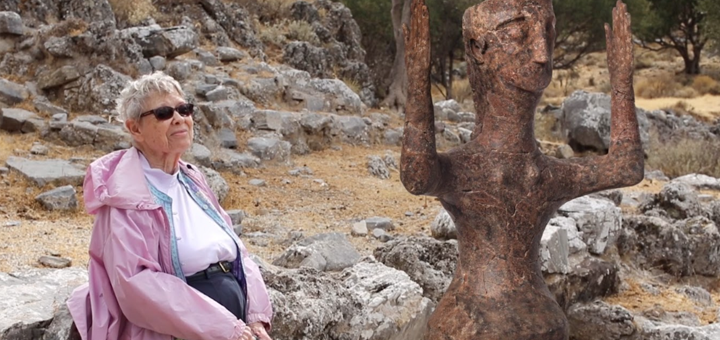Endowment Ensures Gesell’s Study of Ancient Life in Crete Will Continue

Now in her 90s, UT professor emerita Geraldine Gesell still travels to Crete twice a year to research archaeological artifacts found in the Kavousi area.
So, it’s only fitting that the Dr. Geraldine C. Gesell Aegean Prehistory Endowment will ensure her lifelong passion continues into the future. The endowment—established by Gesell’s friend, Richard Sias, with Gesell planning to add funds via a bequest—will provide funding for an Aegean prehistorian who can direct or assist with a field project and train students to work with the Kavousi records.
Gesell earned her bachelor’s degree in Latin at Vassar College and her master’s degree in Latin and ancient Greek at the University of Oklahoma. While teaching Latin at an Oklahoma high school, she attended summer archaeology programs at the American Academy in Rome and the American School of Classical Studies in Athens, Greece.
Inspired by these experiences, she earned her doctorate in classical archaeology at the University of North Carolina, Chapel Hill, in 1972 and was immediately hired as UT’s first classical archaeologist. She stayed until she retired in 2002.
“Dr. Gesell developed a curriculum of archaeology courses that covered all of Greek and Roman antiquity, from the Bronze Age to the end of the Roman empire,” said Aleydis Van de Moortel, who is a Chancellor’s Professor, the Lindsay Young Professor, and head of the Department of Classics. “Classical archaeology is now a popular concentration in our department, and our archaeology curriculum builds on Dr. Gesell’s courses. We are also indebted to her for building a wonderful research library collection together with the dedicated librarians of Hodges Library.”
Gesell began working in Kavousi—a historic village at the eastern end of the Gulf of Mirabello in East Crete, Greece—in 1974. She wanted to locate ancient sites investigated by early American archaeologists. After several years mapping the sites and studying excavated relics, Gesell began directing new excavations in 1987. Excavations continued until 1992 and then work turned to studying artifacts found.
Funding from the National Endowment for the Humanities and the National Geographic Society allowed UT archaeology, agriculture, anthropology, geology, and art students to participate in the project, which has provided a glimpse into life at the end of the Bronze Age and early Iron Age (12th-10th century B.C.).
Gesell has continued her work in Greece in retirement.
“I usually come to Crete in spring and fall for about three months each. I do research and write at the INSTAP Study Center for East Crete in Pacheia Ammos, Crete. It is a study and research center for archaeologists interested in East Crete and stores the artifacts found in excavations,” she said. “I am currently working on the publication of the shrine material of Vronda, a site above the modern village of Kavousi, which the UT team excavated between 1987–1992. We have published four volumes of the Kavousi series with more to come.”
“My interest in this project drives me forward,” the nonagenarian said. “I am eager to fulfill my research and give the knowledge out to the archaeological world.”
-Story by Amy Blakely






